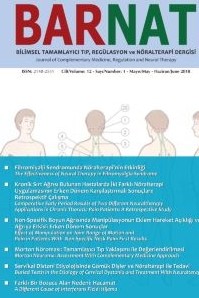KRONİK SIRT AĞRISI BULUNAN HASTALARDA İKİ FARKLI NÖRALTERAPİ UYGULAMASININ ERKEN DÖNEM KARŞILAŞTIRMALI SONUÇLARI: RETROSPEKTİF ÇALIŞMA
Torakal bölge ağrıları Nöralterapi pratiğinde, içerdiği eklem bağlantıları, sempatik innervasyon özelliği ve fonksiyonel anatominin
statik-dinamik durumu nedeniyle önemlidir. Bu çalışmada sırt ağrısı nedeniyle uygulanan 2 farklı nöralterapi enjeksiyon yaklaşımının
sonuçları retrospektif olarak değerlendirilmiştir. Bu amaçla Mart 2017-Mart 2018 tarihleri arasında kronik sırt ağrısı şikayeti ile kliniğimize başvuran 89 hastanın verilerine ulaşılmıştır. Yapılan değerlendirmede malignite, çökme kırığı, aktif dejenerasyon, otoimmün
hastalıklar ve enfeksiyonlar çalışma dışı bırakılmıştır. Bu kriterler dışında kalan 28 hasta çalışmaya dahil edilmiştir.
Hastalar yapılan enjeksiyon türüne göre 2 grup altında incelenmiştir.
- Grup 1 için; romboid, iliokostalis toracis ve paravertebral kaslara tetik nokta enjeksiyonları ve post izometrik germe, Nöralterapi
tekniği ile torakal faset ve kostotransversal eklem enjeksiyonları ve segmental quadel (C3-4, T2-8) yapılan hastaların sonuçları,
- Grup 2 için; romboid, iliokostalis toracis ve paravertebral kaslara tetik nokta enjeksiyonları ve postizometrik germe, Nöralterapi
tekniği ile torakal faset ve kostotransversal enjeksiyonları ve segmental quadel (C3-4 ve T2-8) enjeksiyonlarına ilave olarak; ağrılı
faset eklemlerin seviyesinde yer alan interkostal sinir blokajı, sternokostal eklem ve kostal ark alanında ağrılı bulunan noktalara
tedavi yapılmıştır. Bu hastalara yapılan tedavi sonuçları, VAS (Vizuel Analog Skala), QOLS (Yaşam Kalite Skoru), 3 aylık izlem
süresince yapılan tedavi seans sayıları incelenerek, karşılaştırmalı olarak değerlendirilmiştir.
Yapılan tedaviler sonucu sırt ağrısı şikayeti ile başvuran her 2 hasta grubunda da ağrı sağaltımları etkin olarak düzenlenmiştir. Gruplar
arasında yapılan karşılaştırma sonucu; faset enjeksiyonuna ek olarak anterior bölge bağlantıları ve interkostal sinir bloğunun tedaviye
ilave edilmesinin hastalardaki ağrısızlık süresini uzattığı, VAS değerlerinde daha fazla azalma sağlandığı, yaşam kalitesi skorlarının da
daha yüksek olduğu ve 3 aylık takip süresince daha az tedavi seansı uygulandığı tespit edilmiştir. Bu şikayet ile başvuran hastalarda
genişletilmiş nöralterapi enjeksiyon tekniğinin uygulanmasının daha etkin sonuçlar ortaya çıkardığı düşünülmektedir. .
COMPARATIVE EARLY PERIOD RESULTS OF TWO DIFFERENT NEURALTHERAPY APPLICATIONS IN CHRONIC THORACIC PAIN PATIENTS: A RETROSPECTIVE STUDY
Thoracic pain is an important problem in the practice of neural therapy, because of the sympathetic innervation of the thoracic region, multiple joint involvement both on the posterior and anterior of the thorax, and for functional anatomy of this part of the body.
In this retrospective study, we evaluate the treatment modalities and their results that applied to patients with chronic dorsal pain.
We evaluate the records of the patients with chronic dorsal pain that admitted to our clinic between March 2017 and 2018 in one
year period of time. We reach the records of 89 patient with chronic dorsal pain. The patients with malignancy, vertebral compression fracture, active degeneration, autoimmune diseases, and infection were not included in the study. 28 patients with chronic dorsal
pain were included who were out of these criteria.Patients were divided into two groups according to the type of neural therapy injection.
For Group 1; the paients were choosen from who applied trigger point injections and post-isometric stretching in musculus rhomboideus, musculus iliocostalis thoracis and paravertebral muscles, thoracic facet and costotransversal joint injections according to neural
therapy technique and segmental quadel injections subcutaneusly to C3-5 and T2-8 levels.
For Group 2; the paients were choosen from who applied trigger point injections and post-isometric stretching in musculus rhomboideus, musculus iliocostalis thoracis and paravertebral muscles, thoracic facet and costotransversal joint injections according to
neural therapy technique, segmental quadel injections subcutaneusly to C3-5 and T2-8 levels, intercostal nerve blockage at the level
of painful facet joints, injections of the painful sternocostal joints and tender points in the costal arc area.
The treatment outcomes of these patients were evaluated and compared comparatively according to their VAS (Visual Analogue
Scale), QOLS (Quality of Life Score) and the number of treatment sessions during the 3 months of follow-up.
The lack of prospective study planning with larger number of patients were considered limitations of this study.
In both groups of patients who were treated for complaints of dorsal pain, were effectively treated. With the comparison result
between the groups; injection of anterior region connections and intercostal nerve block treatment that add to group 1 injections,
prolongs the duration of painlessness and less treatment sessions in the patients, further decreases in VAS values, and higher quality
of life scores were determined in group 2 patients.
It is believed that the application of the extended neural therapy injection technique to the patients with this complaint, results in
more effective results.
___
- https://www.theacpa.org/wp-content/uploads/2017/08/Life_Scale_3. pdf (American Chronic Pain Association Quality of Life Scale-A Measure of Function for People With Pain)
